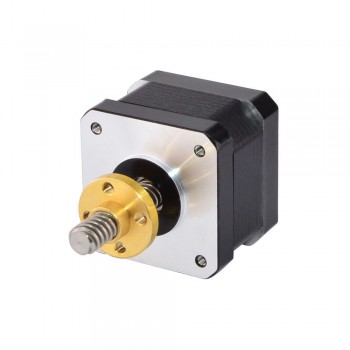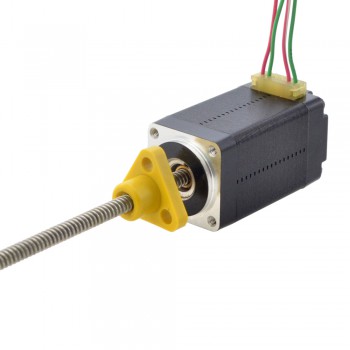Working principle and advantages of linear stepper motor from Minnie's blog
1.What is a linear stepper motor
A linear stepper motor is a special type of stepper motor, and its design and working principle are different from traditional rotary stepper motors. A linear stepper motor is a linear motor that achieves linear displacement through linear motion, rather than the rotational motion achieved by traditional stepper motors.

2.Working principle
The construction of a linear stepper motor usually consists of a fixed stator and a movable slider. The stator is equipped with coils inside, and the slider is equipped with permanent magnets. When current passes through the stator coil, a magnetic field is generated. The permanent magnets on the slider interact with the magnetic field of the stator to generate an attractive or repulsive force, which causes the slider to produce linear motion on the fixed axis.
3.Control method
The control of a linear stepper motor involves multiple components, including a transistor bridge, a pre-driver, and a microcontroller unit (MCU). The transistor bridge is responsible for physically controlling the electrical connection of the motor coil, and the pre-driver is controlled by the MCU to provide the required voltage and current. MCU is responsible for generating specific signals to obtain the required motor behavior
4.Advantages of linear stepper motors (compared to traditional stepper motors)
1.High-speed responsiveness
Generally speaking, the dynamic response time of mechanical transmission parts is several orders of magnitude greater than that of electrical components. Since some mechanical transmission parts with large response time constants such as lead screws are eliminated in the system, the dynamic response performance of the entire closed-loop control system is greatly improved, making the response extremely sensitive and fast.

2.High precision
Since the mechanical transmission mechanism such as lead screws is eliminated, the tracking error caused by the lag of the transmission system during interpolation is reduced. Through linear position detection feedback control, the positioning accuracy of the machine tool can be greatly improved.
3.High transmission stiffness and stable thrust
"Direct drive" improves its transmission stiffness. At the same time, the layout of the linear motor can be arranged according to the surface structure of the machine tool guide rail and the force conditions when the worktable moves. It is usually designed to be evenly distributed and symmetrical to make its movement thrust stable.
4.Fast speed, short acceleration and deceleration process
Linear motors were originally used in maglev trains (with a speed of up to 500km/h). Now they are used in machine tool feed drives. Of course, it is no problem to meet the maximum feed speed of ultra-high-speed cutting (required to reach 60~100m/min or higher). Due to the high-speed responsiveness of "zero transmission", the acceleration and deceleration process is greatly shortened, so that high speed can be reached instantly at startup, and it can stop instantly during high-speed operation. The acceleration can generally reach 2~10g (g=9.8m/s2).
5.Unlimited stroke length
By connecting the fixed part of the linear stepper motor in series on the guide rail, the stroke length of the moving part can be extended infinitely.
6.Low noise during operation
Since the mechanical friction of the transmission screw and other components is eliminated, and the guide rail pair can use rolling guide rails or magnetic pad suspension guide rails (no mechanical contact), the movement noise is greatly reduced.

The Wall